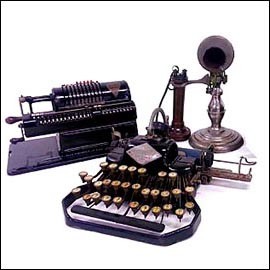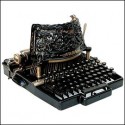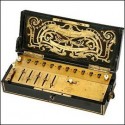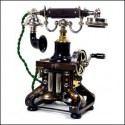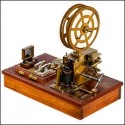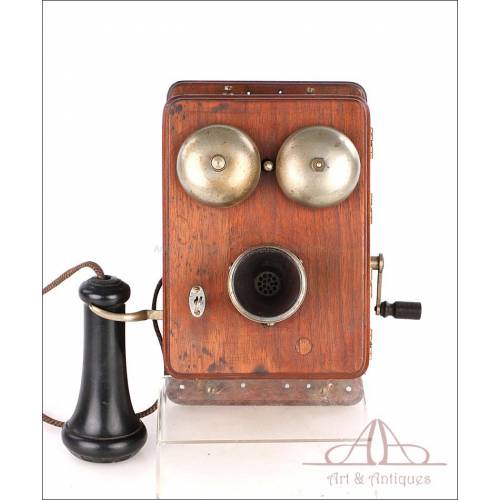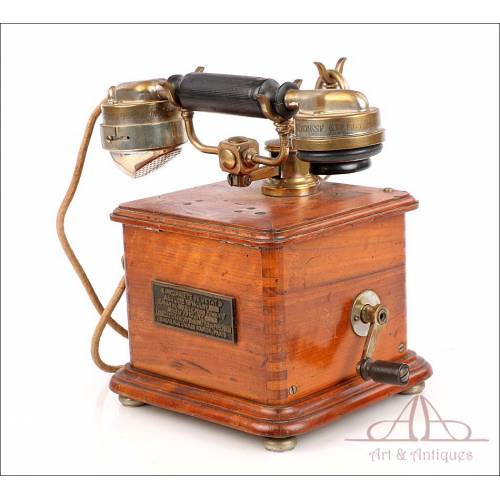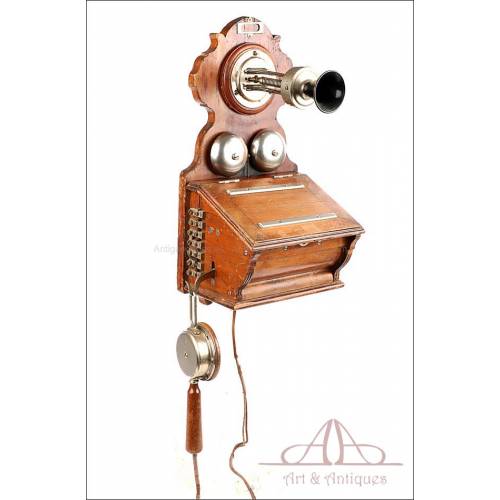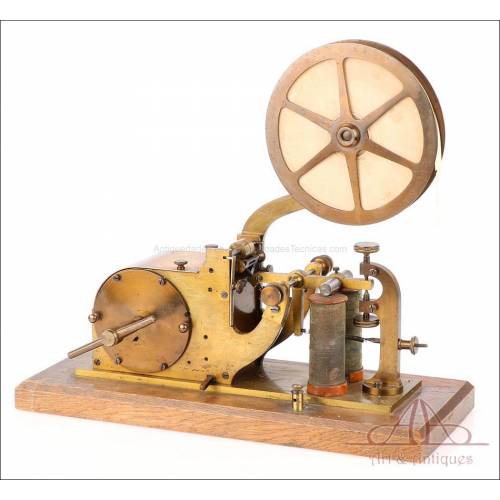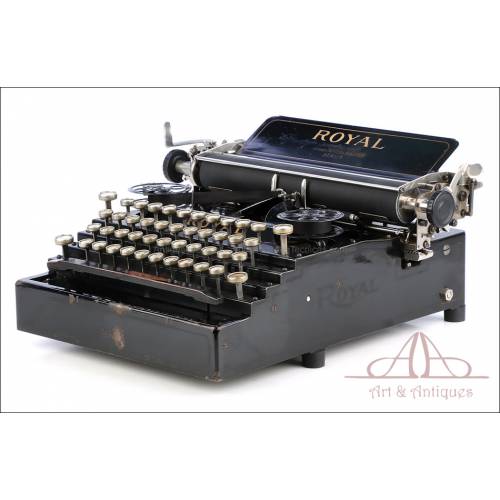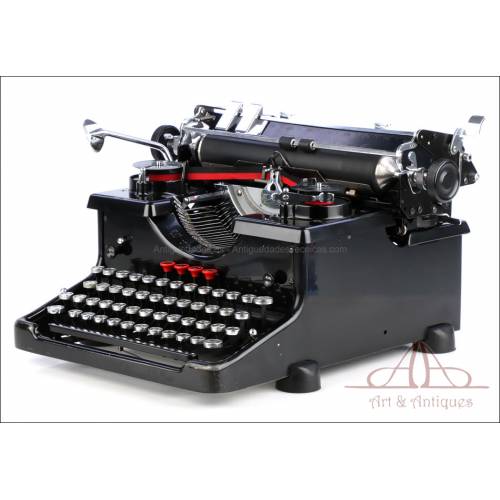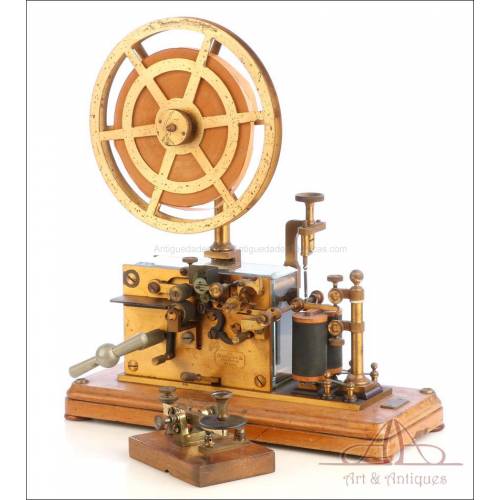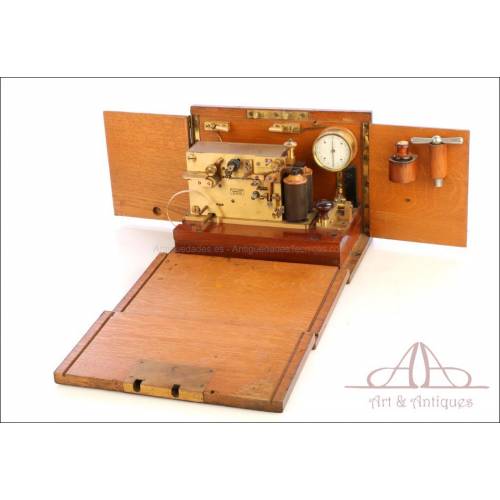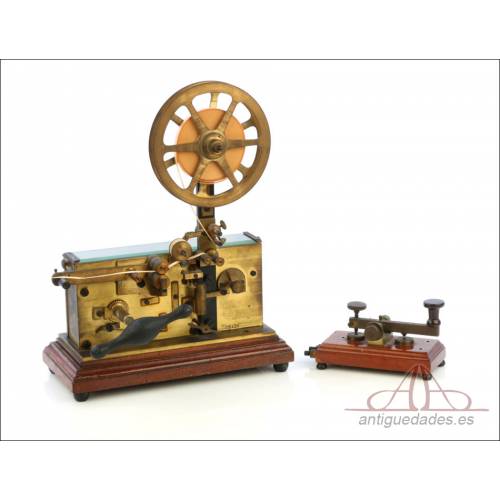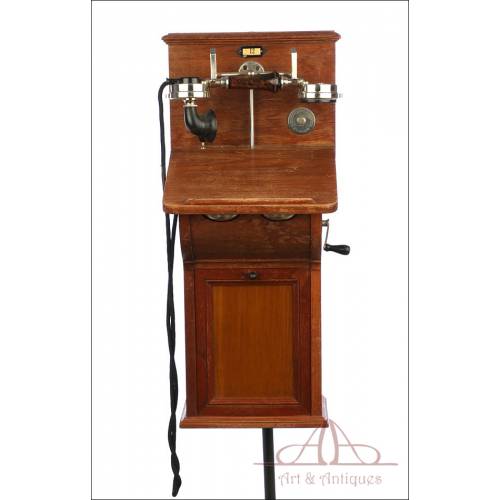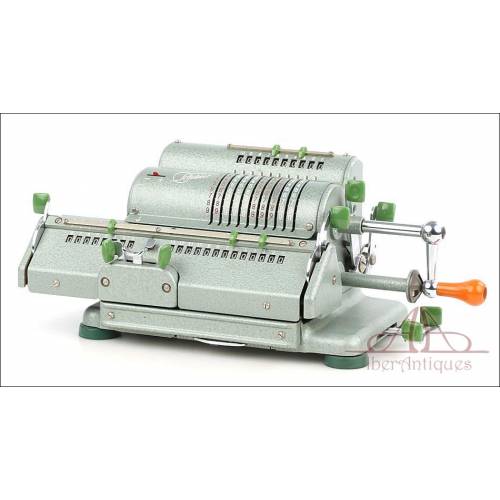Office Antiques
The long history of office work
Office work has a long history. Along with it have been appearing a lot of utensils and work tools to make more effective and bearable the work in any office or administrative space. These office tools have become true jewels over time, given their refined design and sophisticated mechanism. Office work, with its ...
The long history of office work
Office work has a long history. Along with it have been appearing a lot of utensils and work tools to make more effective and bearable the work in any office or administrative space. These office tools have become true jewels over time, given their refined design and sophisticated mechanism. Office work, with its primordial starting point in the invention of the printing press, has been fundamental for the progress of cities, and all the tools that populated the office worker's desk have been witnesses to this.
Office antiques: true collector's gems
Over time, antique office tools and supplies have become true collector's gems. The enormous beauty they possess, coupled with their perfect functionality, have placed them as objects highly appreciated by art and aesthetic beauty lovers. They are highly valued pieces, which can be displayed in your office for the simple pleasure of contemplation, and at the same time can be used to solve the operations and functions required for office work. In any case, owning a collection of antique office items is an unmistakable symptom of good taste.
Pieces that can be found in this section
Among the large number of office antiques offered on the market, below we will expose the most sought after by collectors, given their external aesthetic value and their internal design and functionality. They are as follows:
-Antique typewriters. Without any doubt, antique typewriters are the true crown jewel in any collection of office tools. Machines are preserved in an impeccable condition, perfectly arranged for use. They are of the most legendary brands (Olivetti, Underwood, Remington...) and of a long tradition: from 1880 to the 1950s.
-Antique calculators. Watching the operation of an antique calculating machine is a real treat for the senses. The mechanism with which they are designed is exhibited in a very sophisticated and majestic way. They are true works of art of engineering and hence their high value for collectors. The best brands on the market are offered, from the year 1850 to 1970: Triumphator, Lipsia, Brunsviga, Thales...They are available in a very sophisticated and majestic way.
-Antique telephones. Telephony has improved a lot over time, but the old telephones have left us a real mark for their technological capacity and their beauty. Lovers of this type of antiques will be able to add to their collection wall phones, table phones, wooden phones, Bakelite phones, candle phones, gondola phones, etc. All of these antiques are available in a variety of styles.
-Antique telegraphs. Long before the invention of the telephone and other more modern communication systems, the telegraph, created by Samuel Morse, was in use. Telegraphs are authentic relics, which you can now add to your wonderful collection.The telegraphs are authentic relics, which you can now add to your wonderful collection.
-Other office antiques. Finally, you can complete your fantastic collection of office antiques by collecting other utensils, such as rubber and dry stamps, letter openers, pencil sharpeners, pencil sharpeners, furniture, etc.
Subcategories
Antique Typewriters
Typewriters, a long history of success
If the invention of writing marked the beginning of history itself, the appearance of the typewriter made it possible to refine this technique to unsuspected limits. The first great example came around 1865 under the signature of Rasmus Malling-Hansen. This prototype, named Malling-Hansen in honor of its inventor, was not exactly the first machine of its kind, but it was a pioneer in terms of its commercialization. The path continued in the following decades with the contributions of Remington or Hammond among others, which brought the machines to high levels of popularity. In the first decades of the 20th century, their use was already universal thanks to firms such as Smith Premier or Olivetti, with the arrival of the electric models developed by the International Business Machines Corporation. Today, such a fascinating world is the object of desire of collectors from all over the world.
The great names in antique typewriters
If the general history of typewriters is fascinating, knowing the who's who of the manufacturers who popularized them is a must for collectors.
- Remington: driven mainly by the American Christopher Latham Sholes, it was the first major manufacturer.
- Caligraph - American Writing Machine Company: perfected the manufacture of typewriters to compete head-to-head with Remington. It operated between 1880 and 1908.
- Hammond: founded by James Bartlett Hammond in 1880, his workshop produced the first polyglot machine and a new technical concept. It kept its original name until 1926.
- Yost: synonymous with sophistication, it was born in 1888 driven by George Yost, who had previously worked with Scholes and Caligraph. It remained on the market until 1908.
- Smith Premier: another representative of the early stages of the typewriter industry emerged in 1890 from a gun factory (L.C. Smith & Brothers) and was acquired by Remington in 1908.
- Olivetti: already in the 20th century, Camillo Olivetti was the driving force behind the first major European company (1908). Unlike its predecessors, it is still active today, although oriented towards electronics.
- Underwood: John Thomas Underwood founded it in 1895 and, despite starting behind its main rivals, managed to survive almost all of them and continues to manufacture (with a different orientation) today.
- Many more: Densmore or National Typewriter Company would be other notable examples among several dozens of them
Types of antique typewriters
The first major criterion for classifying these antiques is whether or not they have a keyboard. In the first case, those with an index stand out, which were in turn divided into those with a circular, quadrangular or linear format, being very rare examples and, therefore, coveted. Among those with a keyboard, the main classification criterion is the key stroke (lower, upper, front, rosette...). Finally, the keyboard layout is another important factor for placing machines in one category or another. In spite of the common characteristics, each historical model has some singularities that make it unique and valuable.
Antique Mechanical Calculators
Ancient calculators
In the abacus, the slide rule and other inventions is the origin of calculators. The definitive overcoming of the abacus begins in the 17th century. In the early 19th century, Charles Xavier Thomas of Colmar invented the arithmometer based on the inventions of Pascal and Leibniz. In the 17th century, Pascal had invented a calculator called the pascaline and Leibniz had created a mechanism of mechanical calculator that was called the arithmometer.The arithmometer
Perfected by industry in successive models, the arithmometer, reached full force in the 19th century and its use declined in the first half of the 20th. This metal mechanism inside a wooden or aluminum case is robust, beautiful, scarce and in demand. A benchmark in the industry that currently honors any collection is the Odhner arithmometer, invented in Russia in 1874 by Willgodt Theophil Odhner. The Felix calculator is related to the Odhner. After the Russian Revolution in 1917, Odhner's descendants emigrated to Switzerland and the Russian state nationalized Odher's arithmometer. In 1924, Felix Dherzhinsikye, creator of the Cheka, which later evolved into the KGB, used Odhner's design to manufacture calculators in Moscow until 1978.The comptometer and other antique calculating machines
The comptometer and comptograph competed with the arithmometer from the late 19th century and outlived it until the 1970s. They operate with keys, instead of the windlass that drives the arithmometer mechanism. They are faster, lighter and smaller. In wooden, metal or aluminum cases, mechanical or electric, they are practical, compact and elegant. Introduced in 1948, the Curta is a variant of the arithmometer appreciated by lovers of antique calculating machines. Invented by Curt Herzstark, a prisoner of the Nazi concentration camp of Buchenwald, this portable mechanical calculator tests the power of will and creativity. The dramatic circumstances in which it was created perhaps explain its beautiful hermeticism. Among the rarest in this section, it is not surprising that collectors covet it.The makers of antique calculators
The Germans excel in the manufacture of antique calculating machines. Outstanding among them are Brunsviga, so called because it operated, between 1892 and the 1960s, in the German city of Braunschweig; Thales, which manufactured between 1911 and the late 1960s; Triumphator, which, founded in 1900, operated until 1965; Lipsia, which made calculators between 1914 and 1954; and the Mercedes-Euklid brand, which opened in the early 20th century and from 1945 turned to electric calculator technology. Other manufacturers were the American Burroughs and, in Russia, Odhner.The mechanical calculator as a collectible antique
Beginning in the 1970s, electronic calculators displaced mechanical calculators. Because they are mechanical and because of their incredible quality, antique calculators are still useful. And above all, they are collector's items noted for their majesty, beauty and historical value.Antique Telephones
Antique telephones are pieces of high aesthetic and historical value for collectors of antiques related to communications technology. Since the invention of the telephone in the late 19th century revolutionized communication between people, models have evolved at the speed of light. From the first designs, bulky and complicated to handle, to the current cell phones, the evolution of this invention has been truly spectacular.
Early telephones: the first models
The first known telephone is due to the ingenuity of an Italian inventor, Antonio Meucci. Although for decades the invention of the telephone was attributed to the American Alexander Graham Bell, it was eventually shown that Bell actually patented the invention before Meucci. To solve this mistake, in 2002 the US Congress passed Resolution 269, which returned the paternity of the device to Meucci (who gave it the curious name of telephone).
It was in 1854 when Antonio Meucci built the first known telephone with the intention of communicating the upper floor of his home, where his office was located, with the lower floor, where his wife used to be. Lacking sufficient financial resources, Meucci was unable to register the patent and it ended up being acquired by Alexander Graham Bell. Unfortunately, the Italian inventor passed away without being recognized as the real "father" of this device: an invention that revolutionized the way people communicate with each other, without which we could not understand the evolution of our society.
Types of old telephones
Old telephones can be classified into different types, depending mainly on their design. In reality, the technology that makes them work is basically the same; for this reason, when establishing a typology it is necessary to do so according to their aesthetic characteristics.
Antique candlestick telephones
. Their name comes from the English "candlestick", which actually means "candlestick" and not "candelabra". The vertical and stylized design of these devices earned them this nickname. In Spain they are also known as "candlestick telephones" and even as "candilophones". This design is one of the oldest in history, and lived its golden years between 1890 and 1940.
Antique wall-mounted telephones
. It is estimated that the first models appeared around 1900. The design was intended primarily for public telephones, which were installed in stores or taverns. Their mechanism was coin-operated. Today, among the antique telephones that we can find there are fantastic wall-mounted models, such as the one launched by the Ericsson company in 1912. With solid wood case and double bell, this is one of the most beautiful and sought after antique telephones, of which thousands of imitations have been made. .
Old desktop telephones
. Desktop telephones came after wall-mounted models. To achieve less cumbersome designs, a few years had to pass during which the mechanism became more compact and reliable. The Standard 20 N model, marketed during the 1920s in Spain, is one of the most famous classic designs: there was a desktop and a wall-mounted version. But undoubtedly one of the best known of the old telephones is the famous Heraldo model. Manufactured by Citesa, it was launched in 1963; its popularity was so great that practically every house in Spain had a Heraldo over the next 20 years. These telephones also had their wall-mounted version.
Antique gondola phones
. Like Heraldo phones, gondola phones are not really antique phones, but vintage models. Their origin dates back to theTrendline model (later known as Trimline), a design launched in North America in 1964. A few years later, a senior official of CTNE (later known as Telefónica) traveled to the USA and discovered these telephones. Fascinated by their design and functionality, he commissioned Citesa to mass produce them. Gondola telephones quickly spread throughout Europe, but their introduction into the market was the work of Spanish initiative. Their compact design, the fact that the dialing disc was integrated inside the handset and their attractive aesthetics, very much in line with the industrial design of the time, made them a sales success.
Today, antique telephones still have thousands of admirers who look for them in stores, markets and websites. In many cases their mechanisms can be adapted to the telephone lines of today's homes, becoming not only fantastic antiques, but one hundred percent functional devices. Their boom is a real tribute to one of the most revolutionary and important technological inventions of all time.
Antique Telegraphs
Today it seems impossible that there was a time when there were no means of communicating over distance. But the truth is that until the advent of ancient telegraphs, the only way to contact people and disseminate information was by post. For this reason, the invention of the telegraph can be considered one of the most important in the history of mankind. Thanks to this ingenious device, news began to be known quickly and the way of understanding the world was never the same again. Today, fans of collecting antiques related to communications place a special value on antique telegraphs and their components. And no wonder: these are truly fascinating mechanical pieces, which in many cases are still working and keep intact all their power of attraction.
History of antique telegraphs and Morse apparatus
The name "Morse apparatus" is due to the one who is considered the inventor of the telegraph: Samuel F. B. Morse, an American artist born in 1791. However, although Morse was the first to build a telegraph apparatus as we know it today, a series of discoveries and inventions (by figures such as Francisco Calvá y Campillo and Carl Friedrich Gauss) led to the final design. The story goes that Morse decided to invent a device that could transmit information quickly, after learning of the death of his wife a week after the sad event. In addition to designing the device, Morse created the code that bears his name with the help of Henry and Alfred Vail. The inventor built the first telegraph in 1837, and seven years later the first telegraph communication was made. Ancient telegraphs were the first step for the appearance of one of the most important inventions of the last centuries: the telephone.
Parts of an ancient telegraph station
There are two types of telegraph stations: sending stations and receiving stations. The former have keys, also known as pointers, manipulators or boosters, intended to transmit information in Morse code. The receiving stations, on the other hand, have telegraph printers that print the signs received on reels of paper. These signs are then decoded by an operator, who transforms them into words, phrases and messages. Another important element of the receiving station is the galvanometer, a contribution of the English scientist Lord Kelvin thanks to which the first telegraph cable connecting London with New York was put into operation in 1866.
Collecting antique telegraphs
Antique galvanometers, antique Morse keys and antique telegraphs in general are items full of magnetism, with a beauty and interest given by their functionality. Today, antique telegraph stations and their components(together or separately) are part of the most important collections. We can find magnificent pieces in private collections, but also in the most important science and technology museums in the world. Their precision, their intrinsic beauty and the ingenuity displayed by their invention make them true jewels, treasures of a past time that coincided with the advent of Modernity.
Antique Bell Wooden Telephone. France, Circa 1900 Antique Bell Wooden Telephone....
Authentic antique wall telephone more than one century old. In fine condition and with the original key. Authentic antique wall telephone more...
SoldGorgeous Antique French Desk Telephone Model 1910. France, 1925 Gorgeous Antique French Desk...
Outstanding desk telepohone mod. 1910 with mahogany wooden box. In excellent condition. Museum piece. Outstanding desk telepohone mod. 1910...
SoldVery Antique and Rare Wall Telephone. Circa 1880 Very Antique and Rare Wall...
Antique wooden and metal wall telephone, one of the first ever models manufactured. With original key and in fine condition. Antique wooden and metal wall...
SoldVery Rare Austrian Schaeffler Telegraphic Printer. Wien, 1870 Very Rare Austrian Schaeffler...
Striking antique Schaeffler telegraphic printer. Very uncommon model. In fine condition. Striking antique Schaeffler...
SoldAntique Royal Model 5 Typewriter. England, Circa 1910 Antique Royal Model 5...
Amazing Royal 5 typwewriter Flatbed in very good working order. Original design. Amazing Royal 5 typwewriter Flatbed...
SoldAntique Torpedo 6 Typewriter in Museum Condition. Germany, 1930s Antique Torpedo 6 Typewriter in...
Outstanding Torpedo 6 typewriter in exceptional condition. Almost like new. In perfect working order. Outstanding Torpedo 6 typewriter in...
SoldBeautiful Antique Ericsson Morse Telegraph. Glass Sidewalls. Stockholm, Circa 1900 Beautiful Antique Ericsson Morse...
Amazing antique Morse telegraph in great condition. Perfect as a decorative piece. Fully original. Amazing antique Morse telegraph in...
SoldRare Antique Military Field Telegraph. Copenhagen, Denmark, circa 1900 Rare Antique Military Field...
Amazing and rare antique military telegraph made by Ericsson. In great condition. Entirely original. Amazing and rare antique military...
SoldAntique Italian Telegraph-Morse Station. Italy, Circa 1900 Antique Italian Telegraph-Morse...
Superb telegraph or Morse station in very good condition. With all its original component parts and pieces. Collectors item. Superb telegraph or Morse station in...
SoldAntique Wall Telephone. Ericsson. Switzerland, Circa 1910 Antique Wall Telephone....
Gorgeous antique Ericsson wall telephone nearly one hundred years old. Very decorative item. Entirely original from the time. Gorgeous antique Ericsson wall...
SoldAntique Schubert Mechanical Calculator Mod. DRV. Germany, 1960s Antique Schubert Mechanical...
Nostalgic Schubert DRV pinwheel calculator in striking condition. It is like new and works really fine. Collectors piece. Nostalgic Schubert DRV pinwheel...
Sold
New products
-

19th Century Antique Silver Chalice in Perfect Condition
19th century silver chalice in perfect condition with gilded cup....
-

Antique Spanish Silver Nave. Valladolid, Spain. 18th C. Ca 1775
Rare silver naveta from Valladolid, Spain, circa 1775. Rich vegetal...
-

Antique Gilt Bronze Clock with Cupid. France, circa 1850
Antique French gilt bronze clock with Cupid, circa 1850. Paris 7-day...
-

Spanish HMV Gramophone-Phonograph Model Monarch 13C, Barcelona ca 1915
Exceptional 1915 HMV Monarch 13C gramophone-phonograph with mahogany...
-

Antique Victoria Cigarette Rolling Machine, Spain c.1920
Automatic "Victoria" cigarette rolling machine, made in Spain around...
-

Elegant Antique Gilded Bronze Clock, France ca 1850 - Diana the Huntress
Antique French gilded bronze clock ca. 1850. Diana the Huntress seated...
-

Beautiful Antique Gilt Bronze Mantel Clock. France, circa 1840
Elegante reloj de sobremesa de bronce dorado al mercurio, circa 1840, en...
-

Antique Gilt Bronze Portico Clock with Four Columns. France, 19th Century
Elegant gilt bronze portico clock, France, 19th century. Working condition.
Specials
-

Longines Dolce Vita Wristwatch. Gold and Steel. Quartz. Switzerland, 2005
Outstanding Longines Dolce Vita watch...

